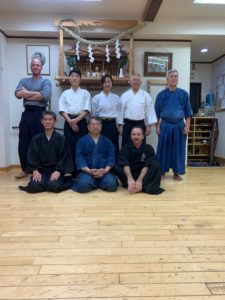Hombu Dojo December 2019
Seizankai Dojo – Machida, Japan
Classes taught follow the example of the classes taught by the Honbu dojo in Machida Japan. So pretty much we do as the Japanese do.
As members of Hataya sensei’s Seizan Kai group, we follow the idea of cutting, tameshgiri and gekken. Classes consists of warm ups, suburi (practice cuts), and kata. As the student develops a strong sense of basics, tameshigiri and gekken will follow.
Taiso (warm-ups)– these are basics warm up exercises to help stretch and prepare for class.
Suburi (practice Cuts)- this is the practice of the 8 directional cuts taught in Toyama Ryu. Basic mechanics and proper grip will be taught and stressed. Also the 8 chiburi and noto along with the 8 stances will be practiced as well.
Kata (forms):
There are 5 sets of kata that will be taught here. Each kata teaches how to handle and deal with a given situation that usually consists of drawing, attacking and then sheathing the sword.
1) 8 Toyama Ryu Kata
2) 7 Gunto Soho (Older Toyama Kata)
3) 6 forms of Kumitachi (2 man forms)
4) The 5 shoden sei tei kata for the ZNBDR/US Battodo Federation
5) The 8 chuden sei tei kata for the ZNBDR/ US Battodo Federation
* Kenjutsu drills with bokken
Tameshigiri:
The purpose of test cutting, tameshigiri in Toyama Ryu Batto Jutsu is to test the cutting ability of the sword, gain experience in striking a solid object and improve timing, distance, angle and grip. Although anyone can “cut”, cutting within the context of the form is a whole different ball game.
The targets used consist of makiwari, tightly rolled straw mats called tatami mats, that have been soaked in water. These offer uniform weight and thickness that best replicate the resistance of human flesh.
Because a samurai lived or died by his ability with a sword, it is essential that he be able to perform a cut successfully. No matter how good the sword or how sharp, it is only as effective as the person weilding it. Hataya Sensei has pointed out to us repeatedly, that no matter how well you are able to perform kata, if the cuts you make in the kata are light and ineffectual, you are only dancing.
For this reason tameshigiri is a fundamental part of Toyama Ryu training. While the kata teaches correct footwork, situational awareness, and body movement, it is only by cutting an actual target that reveals whether or not proper cutting technique is being used. Strength, speed and technique alone are not enough. The correct swing technique and blade angle, hasuji, must combine with proper cutting distance, kirima, to make a successful cut. The mind, body and spirit must fuse at the very instant of cutting. This is the objective of Toyama Ryu Batto Jutsu. (tameshigiri will only be allowed after supervision and approval by Sensei)
Gekken
After kata and tameshgiri, we have gekken. This is actual sparring using foam swords. Although foam, these are not light or flexible like other foam swords. There are no rules and you can try whatever you would like. This helps to learn how to react and distance attacks.
Testing
All testing for dan ranking is done by Hataya Sensei and other Japanese sensei.
DO NOT ask Soriero Sensei to test for dan ranking, you will be asked when Sensei feels you are ready.
Students may test for dan ranking once approved by Soriero Sensei under ZNTIR qualifications.
Note: Students can only test up to San dan ZNTIR until passing Seizankai Shodan. Once a student passes Seizankai Shodan he/she is eligible to test for Yondan ZNTIR (2 years after passing Sandan ZNTIR).
Students may also test for dan ranking under Seizankai qualifications again, once approved by Soriero sensei.
There are cost for testing paid to the Japanese and also passing/registration fees paid to Seizankai and ZNTIR organizations.
Shiseikan dojo passing fees will also be applied.
Zen Nihon Batto Do Renmei/ US Battodo Federation
The Zen Nihon Battodo Renmei and US Battodo Federation (an umbrella group of the All Japan Battodo Renmei) are to help promote the art of Battodo. Because there are many different styles, sei tei (standardized) sets of kata and cutting patterns are used. This helps connect different styles of iai or batto so we can train together and help the art grow.
Zen Nihon Toyamaryu Iaido Renmei
This is the All Japan Toyama Ryu Iaido Federation. We are an official U.S. Branch school. All Toyama Ryu curriculum taught at Shiseikan is from this organization.
Seizankai
The Seizankai is Hataya sensei’s personal group. In it he promotes the elements of kata, cutting, and gekken. Also the testing standards are higher than the normal Toyama Ryu and Battodo Renmei standards. Although it is mainly Toyama Ryu, he brings into it his numerous other experiences with different styles as well. At Shiseikan we train under Seizankai standards.
Shiseikan
Our school name was chosen and given to us by Hataya Sensei in 2013. English translation is: “School of High Integrity”
Kamon (Family crest) Our school Kamon is in honor of my late father-in-law Shoji Hamaguchi – Kioshi 7th Dan Go-Ju Ryu.
Japanese translation of the Kamon is: “Maruni Tachibana” (Orange Blossom in Circle) which is very fitting as we are located in the heart of Florida’s orange groves, Clermont.



